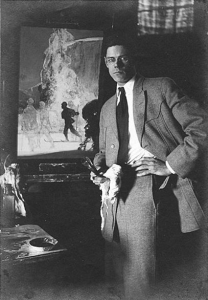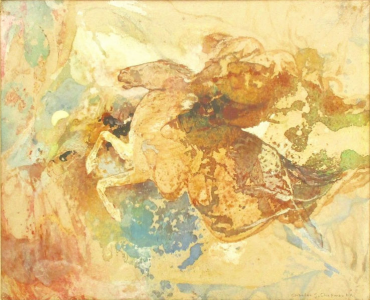
Biography
Charles S. Chapman was born in Morristown, New York, one of three sons of a prominent Morristown banker. As a child he taught himself to draw and spent much of his time in that activity. He attended the Pratt Institute, after which he studied briefly at William Merritt Chase's School of Art in New York. He met Frederick Remington and, at Remington's suggestion, spent a year in the Canadian North Woods in 1902, working as a culler (measurer) of logs and painting scenes of the forest. He settled in Leonia, New Jersey, his wife's hometown, and opened the Leonia School of Illustration with Harvey Dunn.Chapman joined the illustrious Salmagundi art club and won a number of major prizes in exhibitions there. In the early 1920s, he also won prizes from the National Academy of Design. In the 1930s he received a commission from the Museum of Natural History to paint a mural of the Grand Canyon, for which he prepared by camping for several weeks on the Canyon's rim. This is probably Chapman's best-known work. His western travels gave him material for many landscape paintings. Chapman also taught at the Art Students League in New York and illustrated books with western themes.


Critical Analysis
It is hard to judge Chapman's work solely from the Post Office mural he completed for Weirton, West Virginia in 1940, owing to the fact that this mural has been damaged and restored without complete success. One can see a style that is echoed in his illustrations for the Zane Grey book "Tappan's Burro," with dense colors and figures somewhat lost in the immensity of a primeval forest. Remington was impressed by Chapman's use of color, which may be a statement about Remington's own limitations, but certainly applies to Chapman's lovely landscapes.What's interesting about Chapman is that, beyond the landscapes on which he built his career, he was a very experimental painter. In the period after World War I, Chapman spent his summers in a Morristown mansion, where he developed a technique that he called "Water Oils." It involved floating thinned oil colors on water, and then laying a sheet of paper on the floated design. Chapman learned to compose designs in the floating pigments and transfer them to paper for a painting that was abstract, due to the nature of the transfer process, but also representational, due to his care in forming the floating pigments.
Murals
- Weirton, West Virginia - Cove Station Post Office: Captain Bilderbook's and John Schoolcraft's Expedition from Holiday's Cove to Fort Wheeling, 1777
References
- Charles Chapman (1879-1962), Artist (Leonia Public Library Digital Collections).
- Charles S. Chapman (Smithsonian American Art Museum).
- Charles S. Chapman, 83, Prize-Winning Artist, Dies, New York Times December 17 (1962).
- Charles S. Chapman, Teacher, Painter. Morristown, NY (North Country Artists).
- Charles Shepard Chapman (Wikipedia).
- Charles Shepard Chapman (askART).
- Charles Shepard Chapman (Montgomery Museum of Fine Arts).
- Sold at Auction: Charles Shepard Chapman (Invaluable).
- "Strange Reflections" (David Smernoff).
- Zane Grey, Tappan's Burro. Harper and Brothers Publishers , (1923). Illustrated by Charles S. Chapman. Project Gutenberg e-book: https://www.gutenberg.org/files/59548/59548-h/59548-h.htm